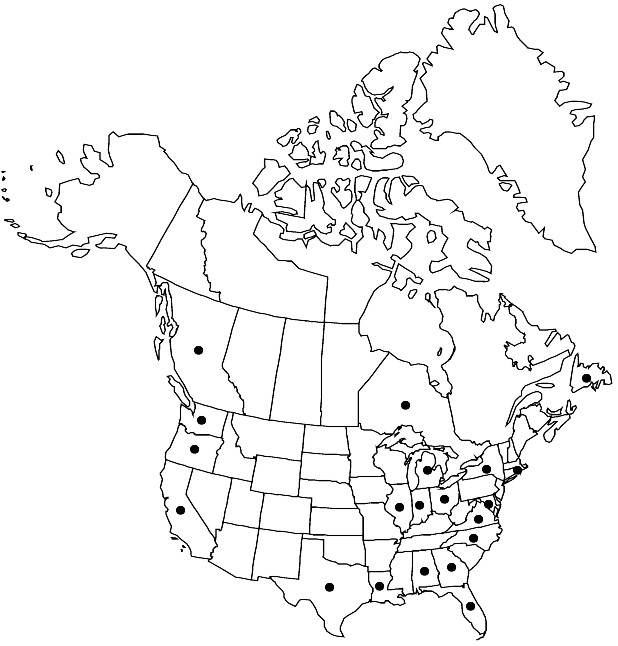Difference between revisions of "Cardamine flexuosa"
Arr. Brit. Pl. ed. 3, 3: 578. 1796.
FNA>Volume Importer |
FNA>Volume Importer |
||
| Line 11: | Line 11: | ||
|name=Cardamine flexuosa subsp. debilis | |name=Cardamine flexuosa subsp. debilis | ||
|authority=O. E. Schulz | |authority=O. E. Schulz | ||
| − | }}{{Treatment/ID/Synonym | + | }} {{Treatment/ID/Synonym |
|name=Cardamine flexuosa var. debilis | |name=Cardamine flexuosa var. debilis | ||
|authority=(O. E. Schulz) T. Y. Cheo & R. C. Fang | |authority=(O. E. Schulz) T. Y. Cheo & R. C. Fang | ||
| − | }}{{Treatment/ID/Synonym | + | }} {{Treatment/ID/Synonym |
|name=Cardamine hirsuta subsp. flexuosa | |name=Cardamine hirsuta subsp. flexuosa | ||
|authority=(Withering) F. B. Forbes & Hemsley | |authority=(Withering) F. B. Forbes & Hemsley | ||
| − | }}{{Treatment/ID/Synonym | + | }} {{Treatment/ID/Synonym |
|name=Cardamine scutata subsp. flexuosa | |name=Cardamine scutata subsp. flexuosa | ||
|authority=(Withering) H. Hara | |authority=(Withering) H. Hara | ||
| Line 35: | Line 35: | ||
|elevation=0-1100 m | |elevation=0-1100 m | ||
|distribution=B.C.;Nfld. and Labr. (Nfld.);Ont.;Ala.;Calif.;Fla.;Ga.;Ill.;Ind.;La.;Md.;Mich.;N.Y.;N.C.;Ohio;Oreg.;R.I.;Tex.;Va.;Wash.;Europe;e Asia;introduced also in Mexico;Central America;South America;Australia. | |distribution=B.C.;Nfld. and Labr. (Nfld.);Ont.;Ala.;Calif.;Fla.;Ga.;Ill.;Ind.;La.;Md.;Mich.;N.Y.;N.C.;Ohio;Oreg.;R.I.;Tex.;Va.;Wash.;Europe;e Asia;introduced also in Mexico;Central America;South America;Australia. | ||
| − | |discussion=<p>According to J. Lihová et al. (2006), the populations referred to Cardamine flexuosa in North America comprise two taxa of different polyploid origins and evolutionary histories: tetraploid C. flexuosa (2n = 32), native to Europe, and the octoploid taxon informally called “Asian C. | + | |discussion=<p>According to J. Lihová et al. (2006), the populations referred to <i>Cardamine flexuosa</i> in North America comprise two taxa of different polyploid origins and evolutionary histories: tetraploid <i>C. flexuosa</i> (2n = 32), native to Europe, and the octoploid taxon informally called “Asian <i>C. flexuosa</i>” (2n = 64), native to eastern Asia. For the latter, the name <i>C. flexuosa</i> <i></i>subsp.<i> debilis</i> can be used. Nevertheless, these two taxa should be recognized at species level and the correct name for the Asian species should be sought. Based on available data, both taxa occupy the same habitats in North America, but the Asian taxon is much more widespread. The occurrence of European <i>C. flexuosa</i> was, until now, confirmed only for Washington, where both taxa have been recorded. More detailed studies of the North American distributions of both these weeds are needed.</p> |
|tables= | |tables= | ||
|references= | |references= | ||
| Line 60: | Line 60: | ||
|publication year=1796 | |publication year=1796 | ||
|special status= | |special status= | ||
| − | |source xml=https://jpend@bitbucket.org/aafc-mbb/fna-data-curation.git/src/ | + | |source xml=https://jpend@bitbucket.org/aafc-mbb/fna-data-curation.git/src/8f726806613d60c220dc4493de13607dd3150896/coarse_grained_fna_xml/V7/V7_726.xml |
|tribe=Brassicaceae tribe Cardamineae | |tribe=Brassicaceae tribe Cardamineae | ||
|genus=Cardamine | |genus=Cardamine | ||
Revision as of 17:59, 18 September 2019
Annuals or biennials; sparsely to densely hirsute basally or throughout, or glabrous. Rhizomes absent. Stems erect, ascending, or decumbent, branched or unbranched, (0.6–)1–5 dm, (slightly flexuous). Basal leaves (often withered by anthesis), not rosulate, 5–15-foliolate, (2.7–)4–14(–19) cm, leaflets petiolulate; petiole 0.7–5 cm, (ciliate or not); lateral leaflet blade oblong, ovate, or elliptic, smaller than terminal, margins entire, repand, crenate, or 3 (or 5)-lobed; terminal leaflet (petiolule 0.3–1.7 cm), blade reniform, broadly ovate, or suborbicular, 0.5–2.5 cm × 4–30 mm, margins repand, crenate, or 3 or 5-lobed. Cauline leaves 3–15, 5–15-foliolate [leaves (2–)3.5–5.5(–7) cm, including petiole], petiolate, leaflets petiolulate; petiole base not auriculate; lateral leaflets similar to basal, (0.4–2.5 mm wide). Racemes ebracteate. Fruiting pedicels divaricate or ascending, (5–)6–14(–17) mm. Flowers: sepals oblong, 1.5–2.5 × 0.7–1 mm, lateral pair not saccate basally; petals white, spatulate, 2.5–4(–5) × 1–1.7 mm; (stamens rarely 4, lateral pair absent); filaments 2–3 mm; anthers ovate, 0.3–0.5 mm. Fruits linear, (torulose), (0.8–)1.2–2.8 cm × 1–1.5 mm; ovules 18–40 per ovary; style 0.3–1(–1.5) mm. Seeds brown, oblong or subquadrate, 0.9–1.5 × 0.6–1 mm, (narrowly margined or not). 2n = 32.
Phenology: Flowering Apr–Jul.
Habitat: Disturbed areas, fields, nurseries, plantations, gardens, flower beds, lawns, roadsides
Elevation: 0-1100 m
Distribution

B.C., Nfld. and Labr. (Nfld.), Ont., Ala., Calif., Fla., Ga., Ill., Ind., La., Md., Mich., N.Y., N.C., Ohio, Oreg., R.I., Tex., Va., Wash., Europe, e Asia, introduced also in Mexico, Central America, South America, Australia.
Discussion
According to J. Lihová et al. (2006), the populations referred to Cardamine flexuosa in North America comprise two taxa of different polyploid origins and evolutionary histories: tetraploid C. flexuosa (2n = 32), native to Europe, and the octoploid taxon informally called “Asian C. flexuosa” (2n = 64), native to eastern Asia. For the latter, the name C. flexuosa subsp. debilis can be used. Nevertheless, these two taxa should be recognized at species level and the correct name for the Asian species should be sought. Based on available data, both taxa occupy the same habitats in North America, but the Asian taxon is much more widespread. The occurrence of European C. flexuosa was, until now, confirmed only for Washington, where both taxa have been recorded. More detailed studies of the North American distributions of both these weeds are needed.
Selected References
None.